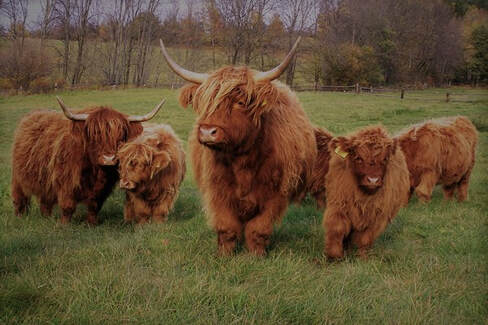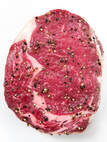
Natural Scottish Highland Heritage Beef
Holy Cross Highland Cattle are milk and grass fed, pastured raised, and free ranging with no added hormones or antibiotics. Scottish highland beef is slow maturing making it a premium lean beef. Because the nature of the cattle and the slow maturing process, the beef is well marbled with low fat content and extraordinarily nuanced flavor. Our pasture raised highland cattle browse our grasslands and forests and in their natural heritage breed slow growth achieve a marbling, tenderness , and flavor far exceeding that of the larger and fast growing breeds.
Holy Cross Highland Cattle are milk and grass fed, pastured raised, and free ranging with no added hormones or antibiotics. Scottish highland beef is slow maturing making it a premium lean beef. Because the nature of the cattle and the slow maturing process, the beef is well marbled with low fat content and extraordinarily nuanced flavor. Our pasture raised highland cattle browse our grasslands and forests and in their natural heritage breed slow growth achieve a marbling, tenderness , and flavor far exceeding that of the larger and fast growing breeds.
 Click Here For a Review of The Best Steaks in the World!
Click Here For a Review of The Best Steaks in the World!
Outstanding Beef Quality: Unlike other breeds, Highlands are slow maturing making the meat tender, flavorful and succulent. Their heavy coats insulate against harsh climates and reduce the development of excess back fat. Recent studies in both North America and the UK have shown that Highland beef is significantly lower in fat content and cholesterol than other cattle breeds. The leanness of the beef compares with chicken and fish fat content.
Highland Cattle Traits
Hair Coat: The double hair coat (long, coarse outer layer and soft wooly inner layer) is one of the most notable differences between Highlands and other breeds. The coat reduces the need for expensive barns and shelters.
Due to the double hair coat, this breed does not need a heavy layer of backfat for insulation. This allows the animal to marble naturally on low input forage while producing lean, low fat, high quality cuts of beef.
Highlands shed out earlier in the spring and produce less hair in a warmer climate, making them suitable for a variety of environments.
Easy Handling: Highlands have a long history of living with humans. Early Scots would keep the family cow(s) inside their homes during the winter. A woven wattle fence would separate the animal’s living areas from that of its owners, with both sharing the added warmth. Highlands tend to be docile and calm and do not stress easily. They are easy to work with despite their long horns. The horns are used primarily for knocking down brush to graze, predator control and scratching. Horns on females are generally upswept and finer textured than those on the males. Male horns are more forward pointing and massive.
Exceptional Mothering and Calving Ease: Highland cows are noted for being highly devoted and protective mothers. They are noted for calving ease. Due to small calf size (60-70 pounds), calving difficulty (dystocia) is less common. Cows may produce into their late teens reducing the need for frequent herd replacement.
Browsing/Grazing Ability: These cattle are excellent browsers. They have been used in the US and worldwide to clear brush lots, for Oak Savannah restoration and grazing improvement projects. Highlands perform well in a variety of feed scenarios whether brush, forage/grass based or grain finished.
Due to the double hair coat, this breed does not need a heavy layer of backfat for insulation. This allows the animal to marble naturally on low input forage while producing lean, low fat, high quality cuts of beef.
Highlands shed out earlier in the spring and produce less hair in a warmer climate, making them suitable for a variety of environments.
Easy Handling: Highlands have a long history of living with humans. Early Scots would keep the family cow(s) inside their homes during the winter. A woven wattle fence would separate the animal’s living areas from that of its owners, with both sharing the added warmth. Highlands tend to be docile and calm and do not stress easily. They are easy to work with despite their long horns. The horns are used primarily for knocking down brush to graze, predator control and scratching. Horns on females are generally upswept and finer textured than those on the males. Male horns are more forward pointing and massive.
Exceptional Mothering and Calving Ease: Highland cows are noted for being highly devoted and protective mothers. They are noted for calving ease. Due to small calf size (60-70 pounds), calving difficulty (dystocia) is less common. Cows may produce into their late teens reducing the need for frequent herd replacement.
Browsing/Grazing Ability: These cattle are excellent browsers. They have been used in the US and worldwide to clear brush lots, for Oak Savannah restoration and grazing improvement projects. Highlands perform well in a variety of feed scenarios whether brush, forage/grass based or grain finished.